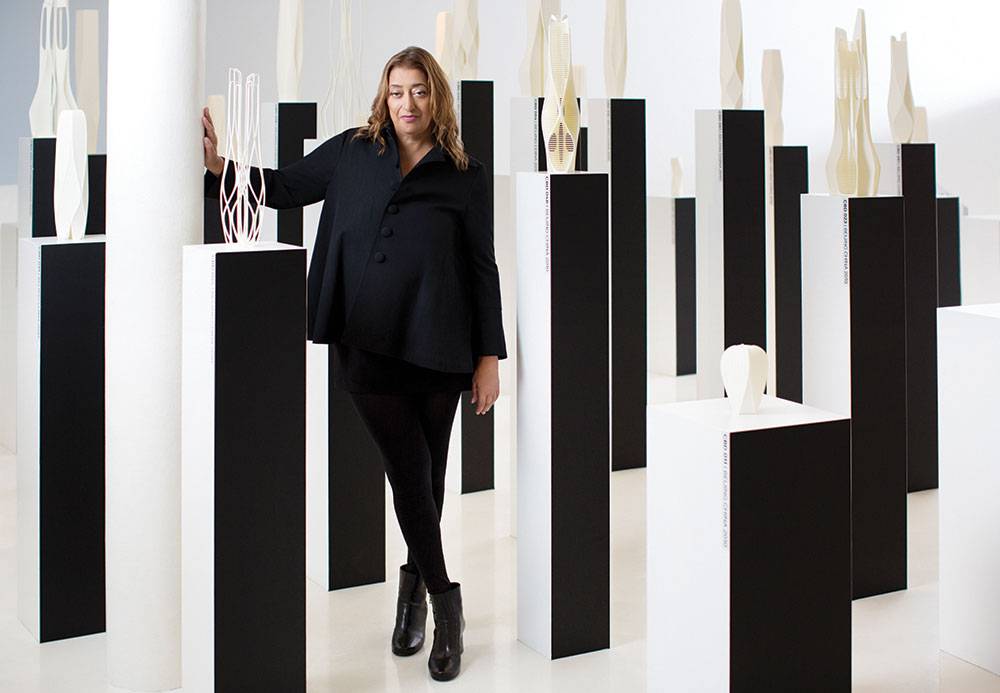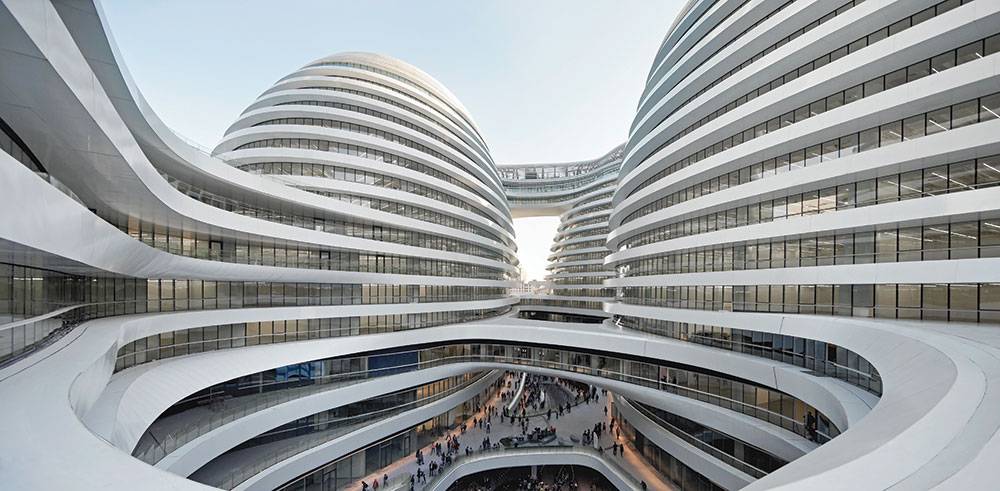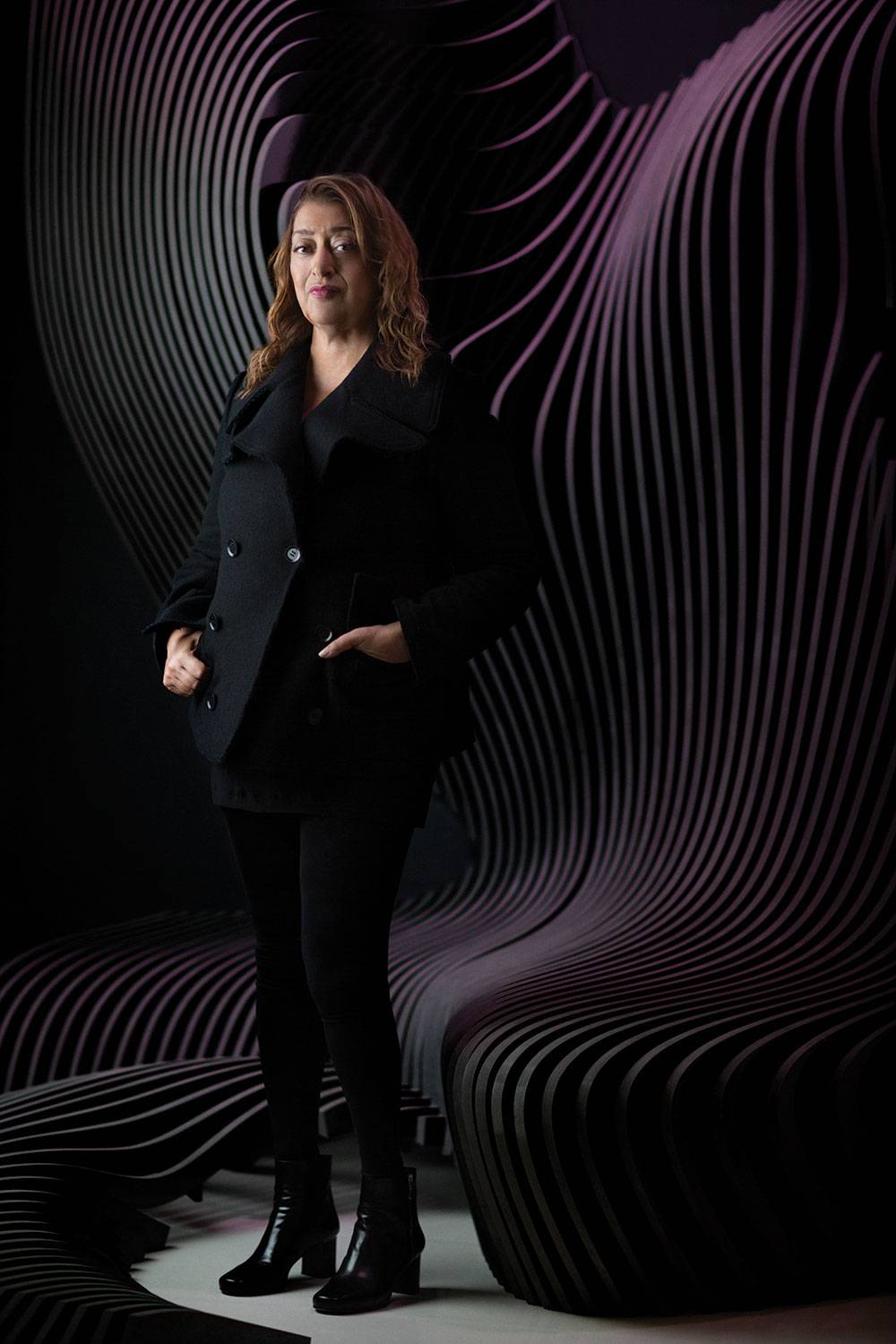
Dame Zaha Hadid was a round peg in a square world, and by her account, always had been. Fortunately, she never conformed, and this is why she was one of the most famous architects in the world.
Her buildings are unlike anything else, featuring bold, sweeping curves that create simultaneously organic and futuristic forms that evoke shells and exoskeletons. And it’s not just the buildings that are different, Zaha herself was unlike any other architect. She was female, she was Iraqi and unlike some of her peers, age did not even slightly tame her brave, bold designs.
Her story is unique. Hadid was born to an affluent family in Baghdad and raised in one of the first Bauhaus-style homes in the city. After graduating from the American University of Beirut with a degree in mathematics in 1972, she attended the Architectural Association School (AA). Although she may not have seen it then, Hadid said “There’s an enormous connection [between the two]. It just organizes your thinking and gives you a certain kind of logic.”

At the AA, she became known as an exceptional but confrontational student who made waves. She was an exotic, chain-smoking Arab girl who challenged all the rules and developed a cult following of fellow students as well as architects and tastemakers like Malcolm McLaran, who were intrigued by her and energized by her work.
She finished with a Diploma Prize in 1977 and became a senior partner with former professor Rem Koolhaas in Rotterdam before founding Zaha Hadid Architects (ZHA) in 1980 in London and opening her first office in 1985. Despite her immediate notoriety, she would not have any of her designs realized until many years later. “Nobody honestly thought I would build anything,” said Hadid.
She had to prove her fantastical designs were feasible to construct to naysayers who felt they might be best left on paper. To make ends meet, Hadid was primarily teaching, lecturing and selling drawings. “That’s how I survived. There were some commissions, but not many,” she recalled. “I think I had a difficult time because people did not think women could get it together. I was also a foreigner here, so that was like a double whammy. The work was not normal to them, so this was a triple whammy. We had to prove that we could do it as well as others.”
This period of drawing, thinking and research allowed her to distill and develop her vision so that when the pieces did finally fall into place, she could hit the ground running. Her first constructed commission came after she won a contest to design a fire station for Vitra, a contemporary German furniture design manufacturer, in 1993.
[highlight_text]“Believe me, architecture is very tough, even if you are successful.There is a lot of demand on you.”[/highlight_text]
Vitra’s campus is comprised of buildings by renowned architects and put Hadid alongside talents like Frank Gehry, Jean Prouvé, and Tadao Ando who had buildings there. It was an early indication that the majority of her work might come from outside her adopted home country of England. This is due in part to her entering and winning many international competitions, a more egalitarian system that awards jobs to the best architect. She liked this system saying, “It is not perfect, but it’s better than nothing. [Otherwise,] if you are not part of a network or a particular club, it might not be possible to have all of this work.”
She did join one very prestigious club in 2002, however. Queen Elizabeth II named her Dame Commander of the Order of the British Empire for her services to architecture. Still, earning titles and winning competitions did not guarantee projects would be built. The lauded Cardiff Bay Opera House in Wales that was scrapped for “structural questions” and The Peak in Hong Kong was never executed due to the timing of the handover to the Chinese.
It wasn’t until 2004 when she won the Pritzker Prize, an international accolade on the level of the Nobel Prize for architects, that her plans started regularly taking their rightful place on terra firma. The prize sent Hadid’s career into overdrive, giving her the distinction of being the only female or Muslim to have won the prestigious award.

In this period, ZHA created the MAXXI: National Museum of XXI Century Arts in Rome and the Evelyn Grace Academy, for which she won Sterling awards in 2010 and 2011, respectively. Other projects include The Guangzhou Opera House in China, The Dubai Opera House in the United Arab Emirates, and The Serpentine Sackler Gallery and Olympic Aquatic Center in London.

The BMW Central Building, a production facility built in 2009 in Leipzig, Germany, won the European Winner of the 2013 Industrial Excellence Award. The structure is unique in that it integrates production with administration, desegregating white and blue-collar workers to a positive end. “I think Germany is amazing to work with,” says Hadid, who also employs many Germans and Austrians at her firm.
Zaha Hadid Architects employs 400 people in central London who have helped her produce 950 plus projects. Nearby, she opened the Zaha Hadid Design Gallery, where her paintings and building models are on view. Every day, items like furniture, lighting, jewelry are also on display and, in some cases, for sale. One example is a drool-worthy pair of $2,000 shoes she designed for United Nude (whose creative director is her former partner, Rem Koolhaas) that seek to reimagine the shoe itself. The shoes employ cutting edge technology and luxurious materials to achieve what no one ever has in the footwear industry.

It stands to reason the shoes would be fabulous. Her fashion sense was impeccable and involved mostly black. “For a long time, I would only wear Japanese designers like Yohji [Yamamoto] and Issey [Miyake] and Comme [des Garçons]. More recently, I have started also wearing Prada or Martin Margiela and things like that,” she said.
Hadid’s foray into the fashion world includes working with fan Donna Karan and Chanel on their Mobile Art Chanel Contemporary Container that touched down in Hong Kong, Tokyo, New York, and Paris.
Despite being undeniably hip, holding teaching positions at Yale, multiple honorary doctorate degrees, and the 2006 Guggenheim exhibition of her work, Hadid had very few stateside projects. Notables were the Rosenthal Center for Contemporary Art in Cincinnati, Ohio, “Elastica,” at the Moore Building in Miami’s Design District, and luxurious One Thousand Museum condominium tower in downtown Miami.

The tower stands out in Miami’s skyline and is ZHA’s first residential tower in the Western Hemisphere. With a maximum of two units per floor, beginning at 4,600 square feet and going up to 10,000, the flow-through units with sunrise and sunset views are spectacular and spacious. The building’s design pushes Miamians’ concept of modernity to the limit, but they appear to be an eager audience to explore their edges. In addition to smart home technology, high-speed elevators, and a bank-style vault, residents enjoy custom kitchens by Gatto Cucine, closets by Molteni & C, and touches like Zaha Hadid Design doorknobs.
Despite all the praise, Hadid had her feet firmly planted on the ground. She’d do any kind of building as long as she felt it was a boon to society. “At the end of the day, space is supposed to enrich your life. Those of us who are lucky, have a home,” she said. “The public domain is very important [to me] because not everybody has luxurious places to live. That’s why schools libraries, theaters and museums should be very interesting.”
[highlight_text]“When I first came to Miami, I really didn’t know too many people. Very quickly they adopted me and looked after me.”[/highlight_text] The Japanese National Stadium, slated for the 2020 Olympics in Tokyo, is making waves with detractors saying the design is too big for the space. But Hadid was quick to point out that she had not yet been asked to change anything. “This was a competition. They wanted a particular stadium, which we provided,” she says matter-of-factly. “If they want a smaller stadium, that’s another story. If they want an 80,000-person stadium, that’s what they’re going to get. It’s like a swimming pool…you can’t shrink it.”
Despite the fuss in Japan, her designs have been widely embraced throughout Asia, and particularly China. “China has been an amazing place to work,” Hadid said. ZHA has done several large-scale projects there including Galaxy Soho in Beijing and the Wangjing Soho complex, dubbed “Three Mountains.” But there is a problem. An exact pirated replica of the distinctive pebble-shaped buildings is already under construction in Chongqing in southwest China and may even be completed before the original.
“I’ve been ripped off a lot and some people say it’s complimentary, but I don’t think so. I don’t know how they got the drawings, but good luck to them,” she said. Despite her obvious ire, she she had better things to do than waste time suing the copy-cats, a wise decision considering China does not have laws protecting intellectual property rights for architecture.

ZHA is extremely busy with a plethora of master-planning projects internationally, for which Hahid had returned for the first time to Iraq since she had left. “Naïvely, I thought it was still the same,” Hadid said of her expectations. “You don’t think of the realities when you are abroad, people left 20 years ago and it was an abandoned, decaying city. There is an enormous connection between that kind of landscape and modernism.” She’s right. Modernist architecture does seem right at home among devastation in our dystopic futurists mind’s eye.
Fortunately, most ZHA creations are not set among rubble, but are rather in some of the most beautiful and interesting places to be in the world. Like the webby megayachts for shipbuilder Blohm + Voss bound to dock at the best ports or One Thousand Museum, perfectly situated in Miami across from Museum Park on Biscayne Boulevard.
Hadid, who died of a heart attack at age 65, will be sorely missed, and her work in architecture will be eternally commemorated.
This interview with Zaha Hadid was originally published in November 2013 as a cover story for Haute Living Miami magazine.





